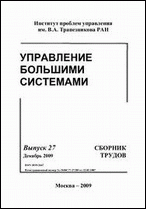|
Network-based models in Control
Statistical analysis and optimization of a tandem queuing systems under prolongable cyclic service
A. Zorine, V. Kocheganov
N.I. Lobachevsky National Research State University of Nizhny Novgorod
Abstract:
Tandem of controlling systems under prolongable cyclic service is presented. There are high and low-priority input flows in each system. Customers of the first system are serviced in class of cyclic algorithms: high-priority customers are serviced fixed amount of time and low-priority customers are then serviced another fixed amount of time. After service high-priority customers of the first system are transferred to the second one. In the second system, customers are serviced in the class of cyclic algorithms with prolongations: in addition to cyclic service it is possible to prolong service of high-priority customers in case amount of low-priority customers is below predefined threshold. Due to cybernetic approach it had become possible to build mathematical model, define necessary random variables and elements with specific distribution, which form Markov chain and represent problem setting. Also it had become possible to construct simulation model to conduct statistical experiments. Paper proposed an algorithm for determining when a stationary mode is reached. Estimators for system performance characteristics are also discussed. Stationary mode existence domain is investigated by means of experiments. In so doingt necessary conditions found by authors analytically are confirmed, and the possibility of their extension is demonstrated.
Keywords:
cybernetic control system, simulation model, cyclic algorithm with prolongations, multidimensional denumerable discrete-time Markov chain.
Received: December 5, 2018
Published: March 31, 2019
Citation:
A. Zorine, V. Kocheganov, “Statistical analysis and optimization of a tandem queuing systems under prolongable cyclic service”, UBS, 78 (2019), 122–148
Linking options:
https://www.mathnet.ru/eng/ubs995 https://www.mathnet.ru/eng/ubs/v78/p122
|

| Statistics & downloads: |
| Abstract page: | 170 | | Full-text PDF : | 81 | | References: | 30 |
|




 Contact us:
Contact us: Terms of Use
Terms of Use
 Registration to the website
Registration to the website Logotypes
Logotypes








 Citation in format
Citation in format 
